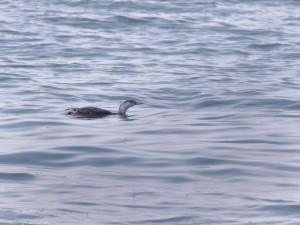Red-throated Loon
 One highlight of a visit to Kiawah Island, South Carolina, last week – March 8-11 – was a beautiful, close-up view of a Red-throated Loon.
One highlight of a visit to Kiawah Island, South Carolina, last week – March 8-11 – was a beautiful, close-up view of a Red-throated Loon.
It was low tide, late morning on a sunny, chilly day. We were walking east on the beach, close to the edge of the waves. Forster’s Terns flew along the edge of the surf, hovering, plunging and flashing silvery white. We passed few other birds, widely scattered – Willets and Sanderlings on the edge of the waves, Brown Pelicans, Ring-billed Gulls, Herring Gulls, Cormorants and one Laughing Gull, flying over. Further east up the beach, we came to several small Dunlins foraging in the sand with Sanderlings, Semipalmated Plovers and four pale Piping Plovers.
 But the best part was seeing the Red-throated Loon at very close range. It was floating in the waves not far from shore, its long body riding low in the water, and a graceful white neck with the bill held slightly up. It dived repeatedly, staying up for only a few seconds at a time before diving again, but it stayed close and was up long enough to see the slender, silky-white throat, the distinct jagged edge of the dark crown and back of its neck, and the dark back speckled with white. These are two of several very good photos Clate took.
But the best part was seeing the Red-throated Loon at very close range. It was floating in the waves not far from shore, its long body riding low in the water, and a graceful white neck with the bill held slightly up. It dived repeatedly, staying up for only a few seconds at a time before diving again, but it stayed close and was up long enough to see the slender, silky-white throat, the distinct jagged edge of the dark crown and back of its neck, and the dark back speckled with white. These are two of several very good photos Clate took.
Though I’ve “seen” more than one Red-throated Loon before, it was always further out off shore, difficult to see well, and fellow birders were telling me that’s what it was as I peered through a scope – but this was the first time one was so clear and close, so that I really felt I could see it well, and had time to watch it for a while.
Red-throated Loons breed in very far northern reaches of North America and Eurasia, and are only found this far south during the winter. During breeding season the head and neck become gray and the dark red throat appears, making it more colorful – but the graceful shape, sleek white throat, black crown and speckled back of the winter plumage are elegant in their own way. “Numbers of this loon have declined recently in several parts of its range in North America,” notes the species account in Birds of North America, “although it is not clear why.” *
When we finally walked on, after watching the loon for several minutes, a very large white bird with long, slender wings tipped in black flew directly over our heads – a Northern Gannet. This was another unusually close view – I could even see the film of gold on the head and the dark-outlined shape of the long, pale, thick bill. Powerful and sleek, it sailed over, circled once, and almost literally disappeared, so quickly gone. I could find no other Gannets in sight, at that time or any other time on this trip to Kiawah, but there may have been others too far out to see.
*Jack F. Barr, Christine Eberl and Judith W. Mcintyre. 2000. Red-throated Loon (Gavia stellata), The Birds of North America Online (A. Poole, Ed.) Ithaca: Cornell Lab of Ornithology.